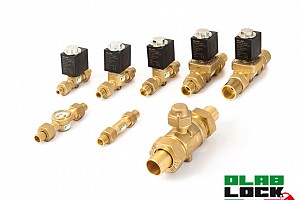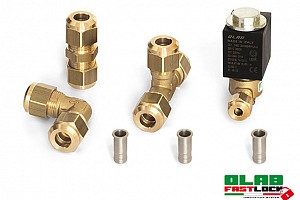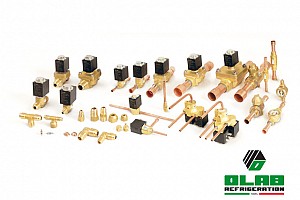gallery-text
OLAB was founded in 1988, but we inherited over 40 years’worth of skills and expertise.
During all this time we have always opted to look to the future, explore new road and focus on new horizons. Which is why our 25.000 m2 production facility is now equipped with state-of –the-art plant and machinery developed especially for us.
Pure technology that enables us to turn out high quality products, for an endless range of applications, with absolutely unparalleled features.
DOWNLOAD REQUEST
BRASS PILOT-OPERATED AND GUIDED DIAPHRAGM SOLENOID VALVES

The pilot-operated solenoid valves manufactured by OLAB, represented by the Series 18000, are on-off valves suitable for liquid and gaseous fluids whose viscosity is not greater than 37 CST (or 5°E).
These are servo-controlled diaphragm solenoid valves with BSPP threaded female inlet-outlet connections (cylindrical for gas), CW617N brass casing and cap, stainless steel magnetic parts and NBR diaphragm for water, EPDM peroxide, FKM (FPM) or other elastomers upon request.
The 18000 valves are of the 2/2-ways normally closed type (2 ways 2 positions), while the 18500 valves are 2/2-ways normally open.
Both versions are available in three models:
- with coil (18000 and 18500) - (protection degree IP00)
- without coil (18010 and 18510)
- with coil + connector (18020 and 18520) - (protection degree IP65 according to the din 40050 standard).
Despite their small weight and size (due to their peculiar profile), they are extremely robust and the fluid temperature are in compliance with gasket materials and the maximum allowable viscosity.
They are suitable for all fluids compatible with the materials which the gaskets and the internal components are made of, except for the dangerous fluids of Group 1 as according to the European Directive 97/23/EC (PED).
The range includes all sizes from 3/8” to 2” with ø11.5 to ø50 (DN) holes, while coils are all Class H for continuous use (ED 100%).
The guided diaphragm pilot operated solenoid valves of the Series 20000 by OLAB are of the guided diaphragm-type with BSPP threaded female inlet and outlet connections (cylindrical for gas), CW617N brass casing and cap, stainless steel magnetic parts and FKM (FPM) diaphragm.
BRASS PILOT-OPERATED SOLENOID VALVES
 |
 |
| NORMALLY CLOSED | NORMALLY OPEN |
The electro-pilot of the pilot-operated solenoid valves is not directly responsible for opening the solenoid valve.
The solenoid valve presents three sequential chambers (see drawing below):
- inlet chamber Ci (upstream the diaphragm)
- compensating chamber Cc (downstream the diaphragm and upstream the electro-pilot)
- outlet chamber Cu (downstream the electro-pilot).
In the 2/2-way normally closed (N.C.) solenoid valve, Ci and Cc are communicating by means of a compensating hole when the coil is de-energized. Therefore, the diaphragm is in a condition of balanced pressure level and DN tightness is ensured by the retaining spring load of the same diaphragm.
When the coil is energized by acting on the electro-pilot, there is an immediate communication between Cc and Cu: the sudden increase in volume of the pressurized fluid over the diaphragm (Cc + Cu > Ci) causes, according to the Boyle-Mariotte’s law, a pressure drop.
The diaphragm is no longer in a condition of balanced pressure level (pressure under it is higher than pressure over it) and swells up in the higher pressure direction raising up and opening the DN to let the fluid flow.
In the 2/2-way normally open (N.A.) solenoid valve, Cc and Cu are communicating when the coil is de-energized and pressure under the diaphragm is higher than pressure over it and as a result, the diaphragm is raised to let the fluid flow.
When instead the coil is energized, the communicating passage between Cc and Cu is closed. The volume available to the pressurized fluid above the diaphragm is suddenly reduced and, always because of the Boyle-Mariotte’s law, this results in a pressure increase above the diaphragm. The lack of balance so produced makes the diaphragm close on the seal.
GENERAL INFORMATIONS
Olab has been producing solenoid valves and fittings for small household appliances for several decades. Over this time research and development have aimed at solving problems felt to be most critical by customers. Part of this research has led to the development of a series of surface treatments complying with the strictest international standards in the food sector.
These treatments, mentioned below, have been applied to our products:
- TM1 (in compliance with the requirements of the American NSF/ANSI ST51 Standard (food equipment materials)
- TM2 (in compliance with the requirements of the NSF/ANSI ST51 American Standard (food equipment materials), NSF/ANSI STD 61 (drinking water system components section 8-ph5 hot commercial 82°C), in compliance with the 1935:2004 European Regulation
- TM3 (in compliance with the 1935:2004 European regulation, only under special conditions)
Our research and development in the field of surface treatments never stopped. Along with the surface treatments mentioned above (proven by several certifications obtained) a new revolutionary treatment has been developed which inhibits the migration of heavy metals at the same time keeping the organoleptic characteristics of fluids unvaried. Almost a year of intensive research resulted in the new TM4 treatment which makes metal surfaces (brass or steel) “impermeable” because of the electrolytic deposition of a double layer of non-toxic agents, which also inhibits the emission of noxious elements.
All items manufactured by OLAB, ranging from solenoid valves to fittings, may be subject to patented surface treatment to give brass surfaces self-lubricating and anti-adhesive characteristics that increase the item’s life (up to three times).
| Yellow brass solenoid valves | ||
 |
 |
 |
 |
 |
 |
| TM1-treated brass solenoid valves | TM2-treated brass solenoid valves | TM4-treated brass solenoid valves |
| OLAB patented treatment in compliance with American NSF/ ANSI ST51 standard (food equipment materials) compliance with european standard 1935:2400 to be considered according to different applications | OLAB patented treatment in compliance with American NSF/ANSI ST51 standard (food equipment materials), nsf/ansi std 61 (drinking water system components) and European (CE) 1935/2004 standard | Almost a year of intensive research resulted in the new TM4 treatment which makes metal surfaces (brass or steel) “impermeable” because of the electrolytic deposition of a double layer of non-toxic agents, which also inhibits the emission of noxious elements. |
Subcategories
Our Products
Cras nec lorem eget ligula varius aliquet at et mi. Fusce id quam in justo suscipit porta. Fusce non nisl nunc, id vestibulum augue.












